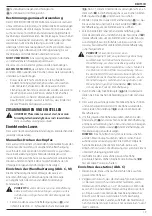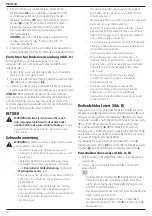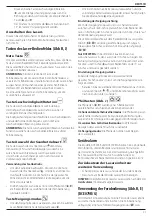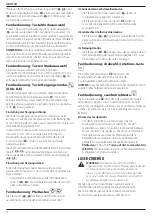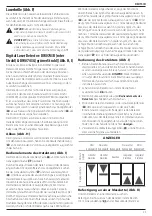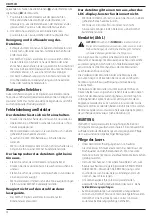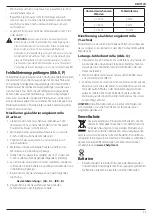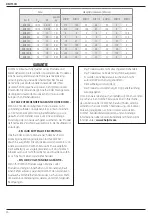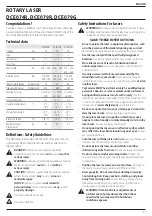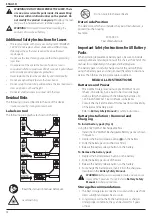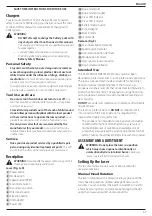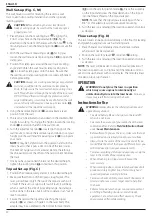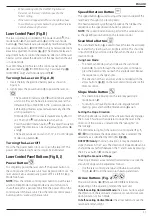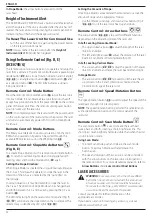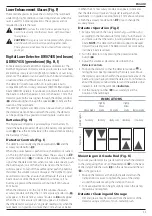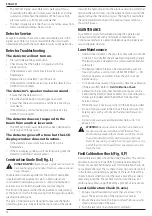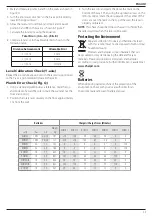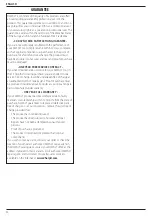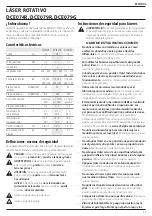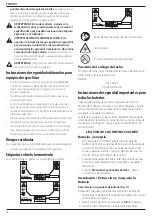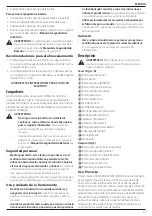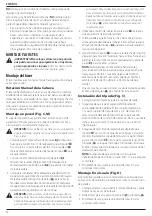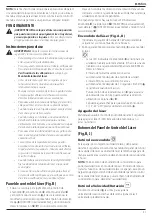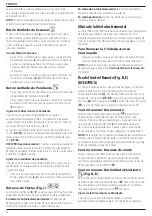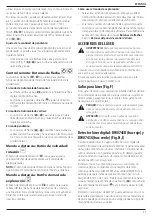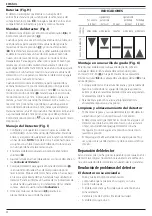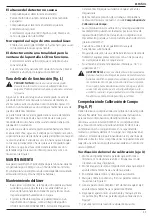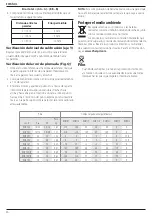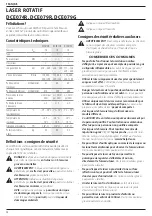
33
EnGLIsH
Laser En hancement Glasses (Fig. F)
These red lens glasses improve the visibility of the laser beam
under bright light conditions or over long distances when the
laser is used for interior applications. These glasses are not
required to operate the laser.
DANGER:
To reduce the risk of serious personal injury,
never stare directly into the laser beam, with or without
these glasses.
CAUTION:
These glasses are not approved safety glasses
and should not be worn while operating other tools.
These glasses do not keep the laser beam from entering
your eyes.
Digital Laser Detector: DW0743R (red beam)
& DW0743G (green beam) (Fig. H, I)
Some laser kits include a
D
e
WALT
Digital Laser Detector. The
D
e
WALT
Digital Laser Detector allows you to locate a laser beam
emitted by a rotary laser in bright light conditions or over long
distances. The detector can be used in both indoor and outdoor
situations where it is difficult to see the laser beam.
The detector is not for use with non-rotating lasers but is
compatible with most rotary red-beam (DW0743R) and green
beam (DW0743G) lasers. It can be set to indicate the location of
the beam to either the nearest 3 mm or the nearest 1 mm. The
detector gives both visual signals through the display window
24
and audio signals through the speaker
25
to indicate the
location of the laser beam.
The
D
e
WALT
Digital Laser Detector can be used with or without
the detector clamp. When used with the clamp, the detector
can be positioned on a grade rod, leveling pole, stud or post.
Batteries (Fig. H)
The Digital Laser Detector is powered by a 9 volt battery. To
install the battery provided, lift up on the battery compartment
cover
30
. Place the 9 volt battery in the compartment, aligning
the battery as shown .
Detector Controls (Fig. I)
The detector is controlled by the power button
26
and the
accuracy mode button
27
.
When the power button is pushed once, the detector is turned
on. The top of the display window shows the accuracy icon
27
,
and the volume icon
28
. To decrease the volume of the audible
signal that the detector emits when it senses a laser beam, push
the button again; one of the half circles next to the horn icon
will dissappear. To turn off the audible signal push the button a
third time; the volume icon will dissapear. The
D
e
WALT
Digital
Laser Detector also has an auto shut-off feature. If a rotary laser
beam does not strike the beam detection window, or if no
buttons are pressed, the detector will shut itself off in about
30 minutes.
When the detector is on, the top of the window shows an
accuracy mode icon. Either the ±1 mm accuracy mode icon
53
will appear, or the ±3 mm accuracy mode icon
54
will appear.
When the ±1 mm accuracy mode icon appears, it indicates
that the detector will give an “on grade” reading only when the
laser beam is on grade or no more than 1 mm above or below
it. When the 3 mm accuracy mode icon appears, it indicates
that the detector will give an “on grade” reading when the
laser beam is on grade or approximately 3 mm above or below
it. Push the accuracy mode button
27
once to change the
accuracy mode.
Detector Operation (Fig. I)
1. Set up and position the rotary laser that you will be using
according to the manufacturer’s directions. Turn the laser on
and make sure that the laser is rotating and emitting a laser
beam.
nOTE:
This detector has been designed to be used
only with a rotating laser. The detector will not work with a
stationary beam laser level.
2. Turn the detector on by pressing the power/volume
button
26
.
3. Adjust the volume as desired as described in the
Detector Controls.
4. Position the detector so that the detector window
24
is
facing the laser beam produced by the rotary laser. Move
the detector up or down within the approximate area of the
beam, until you have centered the detector. For information
about the display window indicators and the audible signal
indicators, refer to the table titled
Indicators.
5. Use the marking notches
29
to accurately mark the
position of the laser beam.
INDICATORS
Above Grade
Slightly
Above
Grade
On Grade
Slightly
below
Grade
Below Grade
audible
signals
fast beep
fast beep
steady tone
slow beep
slow beep
display
icons
Mounting on A Grade Rod (Fig. K)
To secure your detector to a grade rod, first attach the detector
to the clamp using the 1/4"-20 threaded knob
31
on the back
of the clamp. Slide the tracks
32
on the clamp around the rail
33
on the grade rod.
1. Position the detector at the height needed and turn the
clamp knob clockwise to tighten the jaws of the clamp
around the grade securing the clamp on the rod.
2. To make adjustments in height, slightly loosen the clamp,
reposition and retighten.
Detector Cleaning and Storage
• Dirt and grease may be removed from the exterior of the
detector using a cloth or soft, non-metallic brush.
Содержание DCE074R
Страница 1: ...www eu DCE074R DCE079R DCE079G ...
Страница 3: ...1 14 Fig A Fig B 13 12 7 4 5 9 2 11 3 6 1 8 10 7 4 9 2 11 3 6 1 8 10 DCE079R DCE079G DCE074R ...
Страница 4: ...2 Fig D Fig C 5 8 11 5 8 11 15 16 16 17 17 15 Fig E Fig F 18 19 20 22 23 21 RPM 15 45 90 X Y DCE074R ...
Страница 5: ...Dansk 3 30 Fig G Fig H Fig I 26 27 28 53 54 24 24 29 29 25 Fig J ...
Страница 6: ...4 Fig K 33 32 31 Fig M Fig N 42 42 43 45 45 41 39 37 40 40 44 44 Fig L 46 46 ...
Страница 7: ...5 A B L Fig O BB L AA Fig P Fig Q ...
Страница 146: ...DEWALT Industrial Tool Co DCE074R DCE079R and DCE079G DOC 72008247 November 2016 Copyright 2016 DeWALT www DeWALT com ...

